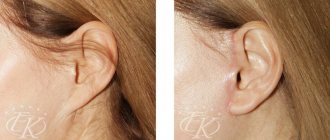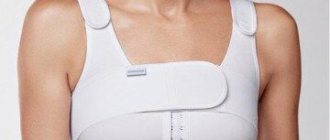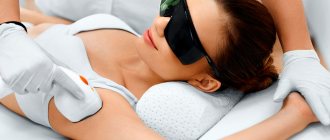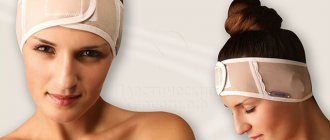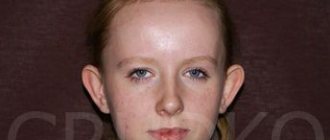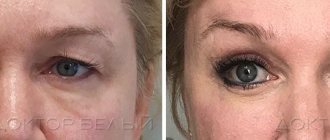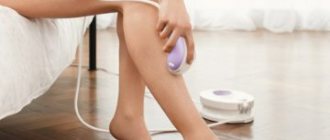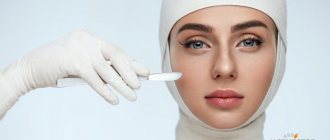Otoplasty: after surgery
Correction of the shape and location of the ears can be carried out under general anesthesia or local anesthesia.
The choice of anesthesia method depends on the characteristics and extent of the surgical intervention, and the patient’s wishes are also taken into account. If you do not want to be conscious during ear surgery, the operation will be performed under light anesthesia. In this case, we recommend staying in the clinic room for the first 24 hours after the correction. If plastic surgery is performed under local anesthesia, you can leave the clinic after 3-4 hours.
What types of dressings are there?
There are two types of fixing bandages:
- compression,
- mask
Differences in species.
The compression product resembles an ordinary hair band and is worn on the top of the head. Made of elastic fabric, it securely fixes the ears and at the same time does not squeeze them. This option is usually prescribed immediately after surgery. The fabric is impregnated with an antibacterial composition to protect intervention areas from infections, but this does not eliminate the need for daily care and treatment of intervention areas. This product is comfortable to wear and breathable (permeable to air).
The mask variety passes under the chin, wraps around the neck and head. This option secures the ears very well, including during sleep, also has the ability to “breathe”, is safe to wear and hypoallergenic. This type of bandage has only one drawback - due to the abundance of tissue layer, the patient may suffer in the heat, especially in the summer.
Bandage after otoplasty
All patients who have undergone otoplasty have an aseptic gauze bandage applied to their ears after surgery. It is fixed on top with a circular elastic bandage. A compression bandage presses the ears to the head, fixes them in an anatomically correct position, and protects the ears from mechanical damage. It also helps reduce the severity of swelling and hematomas after surgery.
The aseptic dressing after otoplasty must be changed every day; as the wound heals, dressings are done every 2-3 days. The compression bandage should be worn continuously during the first week. From the second week it can be removed during the day, but at night you only need to sleep in a bandage.
Otoplasty results
Almost any surgical intervention associated with violations of the integrity of soft tissues and cartilage is accompanied by various consequences. Otoplasty is no exception. The consequences, for the most part, manifest themselves in the form of:
- periodic pain;
- swelling;
- hematoma;
- small scars or scars.
After the operation is completed, the patient is given an anesthetic, but discomfort may continue for several days. Swelling and hematomas appear in 9 out of 10 cases, but disappear on their own after 10-14 days. The formation of scars or scars is possible due to the individual characteristics of the patient’s skin or the low qualifications of the plastic surgeon. You should always carefully choose the person you trust with your health and beauty. In order to avoid negative consequences after otoplasty, you must strictly follow all the doctor’s recommendations.
Swelling after otoplasty and pain
Your ears will hurt a little after otoplasty. As a rule, the pain syndrome is moderate and can be successfully relieved with painkillers. Minor pain persists for several days, after which it disappears completely.
Swelling after otoplasty persists for a longer period - up to two weeks. Anti-inflammatory drugs can be used to reduce the severity of swelling. A compression bandage after otoplasty also helps reduce tissue swelling.
Late postoperative period
The main task of the late period of rehabilitation after otoplasty is to create the most favorable conditions for the healing of the ears.
Rehabilitation ends 25-30 days after surgery and consists of the following:
- adherence to dietary nutrition;
- limiting showering and bathing;
- restriction of physical activity;
- maintaining a comfortable temperature regime.
The late period of rehabilitation after otoplasty is characterized by partial loss of sensitivity, a feeling of discomfort and slight swelling. All this indicates that the tissues are not ready to perform their functions in full.
Rehabilitation after otoplasty: physiotherapy
To accelerate tissue regeneration, hardware cosmetology methods are used. At the SOHO CLINIC, after plastic surgery, patients are prescribed microcurrent therapy using a modern Skin Master Plus device. The purpose of the procedures is to normalize the outflow of lymph and microcirculation, improve oxygenation and nutrition of tissues, and accelerate regeneration. A short course of procedures significantly reduces the duration of the recovery period.
At the SOHO CLINIC, patients after ear plastic surgery are provided with three free physiotherapeutic procedures.
Why is this necessary?
The main task of the product is to fix the ears after surgery, as well as provide reliable protection from possible damage. The product helps maintain the new shape of the ears and prevent the formation of noticeable scars in the surgical area. In general, the following functions of the product can be listed:
- maintaining the final effect of plastic surgery,
- acceleration of the healing process of injured tissues,
- relieving swelling and bruising in the intervention area,
- prevention of the development of the inflammatory process.
In addition to the listed tasks, the bandage also protects injured areas in places where sutures are applied from infections and dirt entering the wounds. Thanks to such extensive functionality and the benefits it brings, the bandage is an essential element of the recovery period.
Rehabilitation after otoplasty: general recommendations
During recovery after ear surgery, general recommendations should be followed. Sports, jogging and other physical activities should be limited for up to two months. The expansion of physical activity is carried out gradually. You cannot visit the solarium or sauna. Hypothermia and direct sunlight should be avoided.
In order for the ears to acquire the correct anatomical shape after otoplasty, you should not use glasses for two months. Women should refrain from wearing jewelry (earrings). It takes about six months to fully recover after ear surgery. During this period, minor residual effects from the operation may remain.
If you still have questions regarding ear plastic surgery and the rehabilitation period after surgery, sign up for a free consultation with a plastic surgeon at SOHO CLINIC. The doctor will answer all questions, tell you about the rules of preparation for plastic surgery and the features of the recovery period.
Limitations after ear surgery
There are some limitations for the early period of rehabilitation after otoplasty. Until the stitches are removed, which is about 7-10 days, washing your hair is not recommended to avoid infection and is strictly prohibited for the first 72 hours after the end of the operation. After the doctor removes the stitches, it is better to start washing your hair with baby shampoo, as it contains fewer chemical components that can cause irritation.
It is best to sleep on your back, and to reduce swelling and reduce the likelihood of it spreading to surrounding tissues, the sleeping position should be semi-sitting.
The rehabilitation period for otoplasty is also accompanied by the treatment of sutures with antimicrobial agents. This allows you to significantly speed up the process of cell regeneration. In addition, do not forget that physical activity can cause sutures to separate and cause scars to appear.
How to wear?
As a rule, wearing is divided into two stages. The product is put on the patient for the first time after surgery and removed on the same day along with the sutures. The second time the dressing is performed 8-10 days later. For one month, the bandage will have to be worn daily, every time before going to bed. This approach protects injured tissue, promotes healing, and prevents possible displacement of the ears.
It should be noted that it is strictly not recommended to make a decision on your own to end the period of wearing a sling. Patients often ask after otoplasty how long to wear the bandage, and the doctor announces the upcoming period. But if after this period the surgeon still has not removed the bandage, the patient should not get rid of it on his own. The decision to remove can only be made by the surgeon.
When to see a doctor
A visit to the surgeon is required if the suture material does not have absorbable properties. In this case, the doctor must remove the threads himself. The patient is strictly prohibited from doing this.
A visit to the surgeon is necessary to re-bandage. In addition, you will have to consult a doctor if any unusual sensations or effects occur - for example, one or more of those mentioned in the previous paragraph.
The result of plastic ear correction is usually visible immediately. But for final tissue engraftment and shrinkage, about 3-6 months should pass. After this period has expired, the final outcome of the operation can be summed up. The patient will have to be patient and listen to his surgeon in everything. However, the result is definitely worth the effort.
Basics of proper care
During the entire period while the suture threads are not yet removed, the patient must carry out mandatory antiseptic treatment of the incision sites. As a rule, a standard solution of chlorhexidine or another agent with a disinfecting effect is used for this. This procedure is required in order to prevent infection from entering the injured areas, which are currently very vulnerable.
Also, in the first days, it is forbidden to wash your hair and wet the incision sites. Any contact with water requires antiseptic treatment of the incisions. You cannot remove the suture material yourself! Even if it seems that it can be done easily and quickly. Only a surgeon can remove the threads. If the threads dissolve, then the patient does not have to worry about it at all.
Ointments, medications and compression bandage
Typically, complications after otoplasty occur in the early postoperative period. These include pain, swelling and bruising. Doctors take all measures to eliminate these manifestations, which depends more on the person being operated on, his compliance with all the advice of specialists and the individual characteristics of his body.
Prevention of complications begins immediately after the end of the operation and consists of putting a postoperative compression bandage on the head. It tightly covers the circumference of the head and fixes the ears. The cosmetic effect of the operation depends on the correct application and use of this dressing.
The bandage keeps the ears in the correct position until the wound heals, preventing the tissue from moving. In addition, it protects against bruises during sleep and at home, and also prevents the spread of swelling and hematoma that forms at the site of the surgical suture.
A compression bandage is made from a simple or elastic bandage. But modern manufacturers have developed a special bandage - it looks like a tennis player’s bandage, but has an adhesive tape that can adjust the fastener and give the product any shape and any size. You need to use a bandage or bandage for 7 to 14 days - the time depends on how the recovery period goes.
The first postoperative dressing is carried out within 24 hours. This is done for early diagnosis of hematomas. The napkin on the wound is replaced with a new one, since the old one is saturated with blood by that time.
The napkin is lubricated with wound-healing ointment: erythromycin, gentamicin or tetracycline. The next dressing and examination is carried out on days 3-4, and after 8 days a third dressing is done.
Then the ends of the absorbable thread fall off or the sutures are removed if silk threads were used for the suture. It is allowed to wear the bandage only at night, so as not to accidentally tuck the ear.
Bandage after otoplasty
Otoplasty is a surgical operation aimed at correcting the shape of the ears.
Pain after surgery is quite common - this is the most common complication after otoplasty. Severe pain near the ears in the first two days indicates a lot of pressure from the bandage on the ears or the formation of a hematoma. If severe pain appears after a few days, this indicates the presence of inflammation.
If pain occurs periodically, this is due to the regeneration of the branches of the greater auricular nerve or other nerves that were transected during surgery. To relieve the patient from discomfort and pain, immediately after the operation, a solution of Marcaine with Adrenaline is injected around the auricle.
The patient is prescribed medications to relieve pain and accelerate healing and tissue restoration. For each patient, medications are prescribed individually, based on the characteristics of the operation and the person being operated on, and possible allergic reactions. To speed up recovery, the following are prescribed:
- analgesics in tablets of non-narcotic action;
- broad-spectrum antibiotics
- external agents in the form of ointments, gels and creams.
A week before surgery and two weeks after it, you should take vitamins to reduce the fragility and permeability of blood vessels. The rehabilitation period and how long the ears take to heal after otoplasty will depend on the implementation of all recommendations and prescriptions.
How to choose?
The main thing when choosing a fixation product is to take into account the volume of the head and choose the appropriate size. There is no need for the patient to make the selection on their own - it is enough to consult with your surgeon before the operation, and the doctor will select the optimally suitable item.
Patients often ask whether it is possible to use an elastic bandage instead of a fixing bandage. Unfortunately, bandaging does not help to fully realize the required functionality of the sling. The main problem with using a bandage is the difficulty with applying pressure. Strong compression can injure the ears, and weak compression cannot keep the shells from moving.
It is not recommended to tie your head with a bandage instead of a bandage.
In addition, a bandage is a rather impractical and even unaesthetic thing. Therefore, it is recommended to use exclusively a specialized product, as it is practical and functional.
Preparation for otoplasty
1-2 weeks before otoplasty, stop taking medications that promote thrombus formation and prevent blood clotting, as well as hormonal and contraceptive drugs. In addition, you will need to temporarily stop smoking and drinking alcohol. During the period of preparation for surgery, it is important to eat properly, sleep at least 7-8 hours a day and avoid stress. Your doctor may prescribe a multivitamin.
Otoplasty is performed in the morning on an empty stomach: the last meal is the evening before (8-12 hours before). In some cases, with the permission of the anesthesiologist, patients are allowed a light breakfast. The morning of surgery, wash your hair and ears. If a major intervention is planned under general anesthesia, a cleansing enema is performed.
It is better to come to the clinic for surgery in clothes with buttons that are not worn over the head. You must take your passport and diagnostic test results with you. Citizens of other countries additionally need a visa and a migration card.
